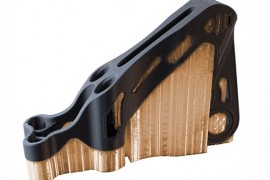
As it could not be otherwise, 3D printing is also very present in the furniture, interior design and decoration sector. The different 3D printing technologies offer new possibilities and manufacturing methods through which it is possible to create furniture with original and innovative designs.
Advantages of 3D printing furniture
3D printing in the furniture sector offers numerous advantages for both designers and end users.
Design
For designers, 3D printing opens up a world of possibilities. Thanks to this manufacturing method and the wide variety of materials available and their possible combinations, it is possible to create furniture with complex geometries that would not be feasible with other manufacturing methods, while achieving a considerable reduction in weight without having to reduce strength.
.jpg)
Image 1: 3D printed chairs designed by Nagami. Source: Nagami design.
Ergonomics
When it comes to ergonomics, 3D printing has much to offer. Thanks to it, it is possible to create furniture that adapts perfectly to its intended use, and 3D scanners can even be used to achieve an exact fit.
Personalisation
This ties in with the issue of customisation. 3D printing and CAD modelling allow full customisation of furniture, whether in terms of size, shape or colour, or in terms of adapting the shape to the end user.
Currently there are companies that offer furniture with online customisation by the user, where the user can choose the colour or size and the furniture is 3D printed with these characteristics exclusively for him. This provides an added value where the end user is part of the result, adding the plus of immediacy.
Economy of materials
3D printing furniture is also cheaper than using other manufacturing methods. This is partly due to the possibility of working with less expensive materials and less wastage.
It can therefore be considered one of the least wasteful manufacturing methods, using only the material intended for the final product.
Sustainability
The manufacture of furniture through 3D printing can be a sustainable option, either because less waste is generated during the manufacturing process, or because of the possibility of using biodegradable, recyclable or recycled materials.
There are several companies and initiatives in different cities around the world, such as Amsterdam (Print your city) or Greece, that 3D print furniture with recycled materials.
.png)
Image 2: Print Your City furniture. Source: Print Your City.
Many of these initiatives consist of 3D printing street furniture made from plastic waste from the cities themselves. In this way, the circular economy is encouraged and as little environmental impact as possible is generated. Moreover, in some of these projects, citizens themselves can be part of the design process of street furniture.
DIY furniture
In addition to the possibilities of design, functionality, customisation and immediacy that 3D printing offers for furniture design and manufacturing companies, it also makes it possible for private users to manufacture their own furniture.
Anyone with a 3D printer at home can 3D print their own furniture. In these cases, parts are often printed that allow for the production of modular furniture, combining 3D printed parts with wooden planks for example. The possibility of creating furniture at home considerably reduces the carbon footprint produced, as large-scale production processes are avoided, as well as the transport of the final product.
The user can design his own shelves, tables, chairs, etc. in a personalised way, adapting them to the style and space available in his home. If the user does not have the necessary knowledge to develop the designs, there is no need to worry, as there are currently various portals where the user can download a multitude of models to print and manufacture their own modular design furniture.

Image 3: 3D printed SuperMod modular shelving. Source: 3Dnatives.
There is no doubt that 3D printing has great advantages in various sectors. In the case of furniture manufacturing, it provides greater freedom for designers, a personalised offer for the end user, the possibility of manufacturing furniture in a sustainable way through the use of recycled materials and even allows private users to manufacture their own furniture at home.












